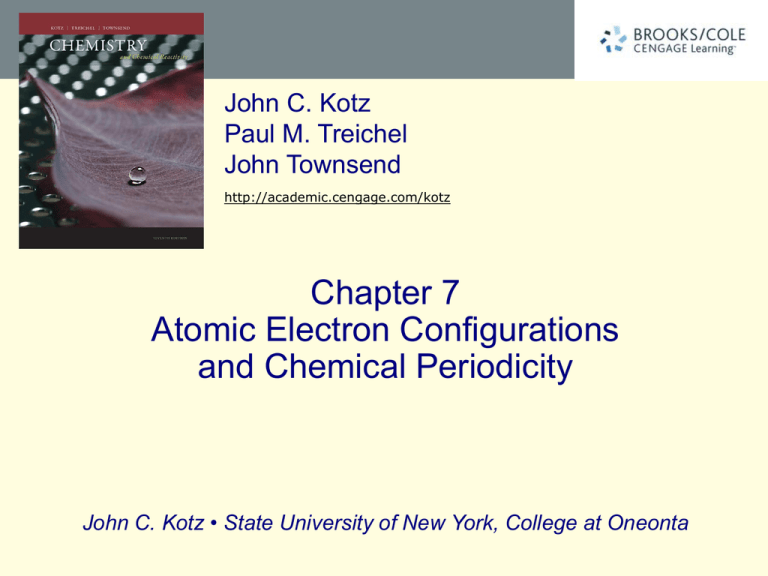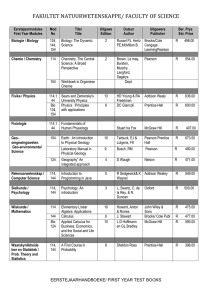Chapter 7 Atomic Electron Configurations and Chemical Periodicity John C. Kotz
advertisement

John C. Kotz Paul M. Treichel John Townsend http://academic.cengage.com/kotz Chapter 7 Atomic Electron Configurations and Chemical Periodicity John C. Kotz • State University of New York, College at Oneonta 2 Important – Read Before Using Slides in Class Instructor: This PowerPoint presentation contains photos and figures from the text, as well as selected animations and videos. For animations and videos to run properly, we recommend that you run this PowerPoint presentation from the PowerLecture disc inserted in your computer. Also, for the mathematical symbols to display properly, you must install the supplied font called “Symb_chm,” supplied as a cross-platform TrueType font in the “Font_for_Lectures” folder in the "Media" folder on this disc. If you prefer to customize the presentation or run it without the PowerLecture disc inserted, the animations and videos will only run properly if you also copy the associated animation and video files for each chapter onto your computer. Follow these steps: 1. Go to the disc drive directory containing the PowerLecture disc, and then to the “Media” folder, and then to the “PowerPoint_Lectures” folder. 2. In the “PowerPoint_Lectures” folder, copy the entire chapter folder to your computer. Chapter folders are named “chapter1”, “chapter2”, etc. Each chapter folder contains the PowerPoint Lecture file as well as the animation and video files. For assistance with installing the fonts or copying the animations and video files, please visit our Technical Support at http://academic.cengage.com/support or call (800) 423-0563. Thank you. © 2009 Brooks/Cole - Cengage ATOMIC ELECTRON CONFIGURATIONS AND PERIODICITY © 2009 Brooks/Cole - Cengage 3 Arrangement of Electrons in Atoms Electrons in atoms are arranged as SHELLS (n) SUBSHELLS (s) ORBITALS (ms) © 2009 Brooks/Cole - Cengage 4 Arrangement of Electrons in Atoms Each orbital can be assigned no more than 2 electrons! This is tied to the existence of a 4th quantum number, the electron spin quantum number, ms. © 2009 Brooks/Cole - Cengage 5 6 PLAY MOVIE Electron Spin Quantum Number, ms Can be proved experimentally that electron has an intrinsic property referred to as “spin.” Two spin directions are given by ms where ms = +1/2 and -1/2. © 2009 Brooks/Cole - Cengage Electron Spin and Magnetism •Diamagnetic: NOT attracted to a magnetic field •Paramagnetic: PLAY MOVIE © 2009 Brooks/Cole - Cengage substance is attracted to a magnetic field. •Substances with unpaired electrons are paramagnetic. 7 Measuring Paramagnetism Paramagnetic: substance is attracted to a magnetic field. Substance has unpaired electrons. Diamagnetic: NOT attracted to a magnetic field See Active Figure 6.18 © 2009 Brooks/Cole - Cengage 8 9 QUANTUM NUMBERS Now there are four! n f shell 1, 2, 3, 4, ... s f subshell 0, 1, 2, ... n - 1 ms f orbital - s ... 0 ... + s ms f electron spin +1/2 and -1/2 © 2009 Brooks/Cole - Cengage 10 Pauli Exclusion Principle No two electrons in the same atom can have the same set of 4 quantum numbers. That is, each electron has a unique address. © 2009 Brooks/Cole - Cengage Electrons in Atoms When n = 1, then s = 0 this shell has a single orbital (1s) to which 2ecan be assigned. When n = 2, then s = 0, 1 2s orbital 2e- three 2p orbitals 6e- TOTAL = 8e- © 2009 Brooks/Cole - Cengage 11 Electrons in Atoms When n = 3, then s = 0, 1, 2 3s orbital 2ethree 3p orbitals 6efive 3d orbitals 10eTOTAL = 18e- © 2009 Brooks/Cole - Cengage 12 Electrons in Atoms When n = 4, then s = 0, 1, 2, 3 4s orbital three 4p orbitals five 4d orbitals seven 4f orbitals TOTAL = © 2009 Brooks/Cole - Cengage 2e6e10e14e32e- And many more! 13 14 © 2009 Brooks/Cole - Cengage 15 Assigning Electrons to Atoms • Electrons generally assigned to orbitals of successively higher energy. • For H atoms, E = - C(1/n2). E depends only on n. • For many-electron atoms, energy depends on both n and s. • See Active Figure 7.1 and Figure 7.2 © 2009 Brooks/Cole - Cengage Assigning Electrons to Subshells PLAY MOVIE © 2009 Brooks/Cole - Cengage • In H atom all subshells of same n have same energy. • In many-electron atom: a) subshells increase in energy as value of n + s increases. b) for subshells of same n + s, subshell with lower n is lower in energy. 16 17 Electron Filling Order See Figure 7.2 © 2009 Brooks/Cole - Cengage Effective Nuclear Charge, Z* • Z* is the nuclear charge experienced by the outermost electrons. See Figure 7.3 • Explains why E(2s) < E(2p) • Z* increases across a period owing to incomplete shielding by inner electrons. • Estimate Z* = [ Z - (no. inner electrons) ] • Charge felt by 2s e- in Li Z* = 3 - 2 = 1 • Be Z* = 4 - 2 = 2 • B Z* = 5 - 2 = 3 and so on! © 2009 Brooks/Cole - Cengage 18 19 Effective Nuclear Charge See Figure 7.3 Z* is the nuclear charge experienced by the outermost electrons. Electron cloud for 1s electrons © 2009 Brooks/Cole - Cengage 20 Writing Atomic Electron Configurations Two ways of writing configs. One is called the spdf notation. spdf notation for H, atomic number = 1 1 1s value of n © 2009 Brooks/Cole - Cengage no. of electrons value of l Writing Atomic Electron Configurations Two ways of writing configs. Other is called the orbital box notation. ORBITAL BOX NOTATION for He, atomic number = 2 Arrows 2 depict electron spin 1s 1s One electron has n = 1, s = 0, ms = 0, ms = + 1/2 Other electron has n = 1, s = 0, ms = 0, ms = - 1/2 © 2009 Brooks/Cole - Cengage 21 22 See “Toolbox” in ChemNow for Electron Configuration tool. © 2009 Brooks/Cole - Cengage Electron Configurations and the Periodic Table 23 See Active Figure 7.4 © 2009 Brooks/Cole - Cengage Lithium Group 1A Atomic number = 3 1s22s1 f 3 total electrons 3p 3s 2p 2s 1s © 2009 Brooks/Cole - Cengage 24 25 Beryllium 3p 3s 2p 2s 1s © 2009 Brooks/Cole - Cengage Group 2A Atomic number = 4 1s22s2 f 4 total electrons Boron 3p 3s 2p 2s 1s © 2009 Brooks/Cole - Cengage Group 3A Atomic number = 5 1s2 2s2 2p1 f 5 total electrons 26 Carbon Group 4A Atomic number = 6 1s2 2s2 2p2 f 6 total electrons 3p 3s 2p 2s 1s © 2009 Brooks/Cole - Cengage Here we see for the first time HUND’S RULE. When placing electrons in a set of orbitals having the same energy, we place them singly as long as possible. 27 28 Nitrogen 3p 3s 2p 2s 1s © 2009 Brooks/Cole - Cengage Group 5A Atomic number = 7 1s2 2s2 2p3 f 7 total electrons 29 Oxygen 3p 3s 2p 2s 1s © 2009 Brooks/Cole - Cengage Group 6A Atomic number = 8 1s2 2s2 2p4 f 8 total electrons 30 Fluorine 3p 3s 2p 2s 1s © 2009 Brooks/Cole - Cengage Group 7A Atomic number = 9 1s2 2s2 2p5 f 9 total electrons 31 Neon Group 8A Atomic number = 10 1s2 2s2 2p6 f 10 total electrons 3p 3s 2p 2s 1s © 2009 Brooks/Cole - Cengage Note that we have reached the end of the 2nd period, and the 2nd shell is full! 32 Electron Configurations of p-Block Elements PLAY MOVIE © 2009 Brooks/Cole - Cengage Sodium Group 1A Atomic number = 11 1s2 2s2 2p6 3s1 or “neon core” + 3s1 [Ne] 3s1 (uses rare gas notation) Note that we have begun a new period. All Group 1A elements have [core]ns1 configurations. © 2009 Brooks/Cole - Cengage 33 34 Aluminum Group 3A Atomic number = 13 1s2 2s2 2p6 3s2 3p1 [Ne] 3s2 3p1 All Group 3A elements have [core] ns2 np1 configurations where n is the period number. 3p 3s 2p 2s 1s © 2009 Brooks/Cole - Cengage 35 Phosphorus Yellow P Group 5A Atomic number = 15 1s2 2s2 2p6 3s2 3p3 [Ne] 3s2 3p3 All Group 5A elements have [core ] ns2 np3 configurations where n is the period number. Red P 3p 3s 2p 2s 1s © 2009 Brooks/Cole - Cengage 36 Calcium Group 2A Atomic number = 20 1s2 2s2 2p6 3s2 3p6 4s2 [Ar] 4s2 All Group 2A elements have [core]ns2 configurations where n is the period number. © 2009 Brooks/Cole - Cengage Electron Configurations and the Periodic Table © 2009 Brooks/Cole - Cengage 37 Transition Metals Table 7.4 All 4th period elements have the configuration [argon] nsx (n - 1)dy and so are d-block elements. Chromium © 2009 Brooks/Cole - Cengage Iron Copper 38 Transition Element Configurations 3d orbitals used for Sc-Zn (Table 7.4) © 2009 Brooks/Cole - Cengage 39 40 © 2009 Brooks/Cole - Cengage Lanthanides and Actinides All these elements have the configuration [core] nsx (n - 1)dy (n - 2)fz and so are f-block elements. Cerium [Xe] 6s2 5d1 4f1 Uranium [Rn] 7s2 6d1 5f3 © 2009 Brooks/Cole - Cengage 41 Lanthanide Element Configurations 4f orbitals used for Ce - Lu and 5f for Th - Lr (Table 7.2) © 2009 Brooks/Cole - Cengage 42 43 © 2009 Brooks/Cole - Cengage Ion Configurations To form cations from elements remove 1 or more e- from subshell of highest n [or highest (n + l)]. P [Ne] 3s2 3p3 - 3e- f P3+ [Ne] 3s2 3p0 3p 3p 3s 3s 2p 2p 2s 2s 1s 1s © 2009 Brooks/Cole - Cengage 44 Ion Configurations For transition metals, remove ns electrons and then (n - 1) electrons. Fe [Ar] 4s2 3d6 loses 2 electrons f Fe2+ [Ar] 4s0 3d6 Fe2+ Fe 4s 3d To form cations, always remove electrons of highest n value first! © 2009 Brooks/Cole - Cengage 4s 3d Fe3+ 4s 3d 45 Ion Configurations How do we know the configurations of ions? Determine the magnetic properties of ions. Sample of Fe2O3 © 2009 Brooks/Cole - Cengage Sample of Fe2O3 with strong magnet 46 Ion Configurations How do we know the configurations of ions? Determine the magnetic properties of ions. Ions with UNPAIRED ELECTRONS are PARAMAGNETIC. Without unpaired electrons DIAMAGNETIC. Fe3+ ions in Fe2O3 have 5 unpaired electrons and make the sample paramagnetic. © 2009 Brooks/Cole - Cengage 47 48 PLAY MOVIE PLAY MOVIE PERIODIC TRENDS © 2009 Brooks/Cole - Cengage PLAY MOVIE General Periodic Trends • Atomic and ionic size • Ionization energy • Electron affinity Higher effective nuclear charge Electrons held more tightly Larger orbitals. Electrons held less tightly. © 2009 Brooks/Cole - Cengage 49 Effective Nuclear Charge, Z* • Z* is the nuclear charge experienced by the outermost electrons. See Figure 7.3 • Explains why E(2s) < E(2p) • Z* increases across a period owing to incomplete shielding by inner electrons. • Estimate Z* = [ Z - (no. inner electrons) ] • Charge felt by 2s e- in Li Z* = 3 - 2 = 1 • Be Z* = 4 - 2 = 2 • B Z* = 5 - 2 = 3 and so on! © 2009 Brooks/Cole - Cengage 50 51 Effective Nuclear Charge See Figure 7.3 Z* is the nuclear charge experienced by the outermost electrons. Electron cloud for 1s electrons © 2009 Brooks/Cole - Cengage 52 Effective Nuclear Charge Z* The 2s electron PENETRATES the region occupied by the 1s electron. 2s electron experiences a higher positive charge than expected. PLAY MOVIE © 2009 Brooks/Cole - Cengage Effective Nuclear Charge, Z* • Atom • • • • • • • Li Be B C N O F Z* Experienced by Electrons in Valence Orbitals +1.28 ------+2.58 Increase in +3.22 Z* across a +3.85 period +4.49 +5.13 [Values calculated using Slater’s Rules] © 2009 Brooks/Cole - Cengage 53 Orbital Energies Orbital energies “drop” as Z* increases ChemNow Screens 8.9 - 8.13, Simulations © 2009 Brooks/Cole - Cengage 54 General Periodic Trends • Atomic and ionic size • Ionization energy • Electron affinity Higher effective nuclear charge Electrons held more tightly Larger orbitals. Electrons held less tightly. © 2009 Brooks/Cole - Cengage 55 56 Atomic Radii See Active Figure 7.8 © 2009 Brooks/Cole - Cengage 57 Atomic Size • Size goes UP on going down a group. See Figure 7.8. • Because electrons are added further from the nucleus, there is less attraction. • Size goes DOWN on going across a period. © 2009 Brooks/Cole - Cengage 58 Atomic Size Size decreases across a period owing to increase in Z*. Each added electron feels a greater and greater + charge. Large Small Increase in Z* © 2009 Brooks/Cole - Cengage 59 Trends in Atomic Size See Active Figure 7.8 Radius (pm) 250 K 1st transition series 3rd period 200 Na 2nd period Li 150 Kr 100 Ar Ne 50 He 0 0 5 10 15 20 25 Atomic Number © 2009 Brooks/Cole - Cengage 30 35 40 Sizes of Transition Elements See Figure 7.9 © 2009 Brooks/Cole - Cengage 60 Sizes of Transition Elements See Figure 7.9 • 3d subshell is inside the 4s subshell. • 4s electrons feel a more or less constant Z*. • Sizes stay about the same and chemistries are similar! © 2009 Brooks/Cole - Cengage 61 Density of Transition Metals 25 20 6th period Density (g/mL) 15 10 5th period 4th period 5 0 3B 4B 5B 6B 7B 8B Group © 2009 Brooks/Cole - Cengage 1B 2B 62 Ion Sizes Li,152 pm 3e and 3p © 2009 Brooks/Cole - Cengage Does+ the size go up+ or down Li , 60 pm when an 2e and 3losing p electron to form a cation? 63 64 Ion Sizes + Li,152 pm 3e and 3p Li + , 78 pm 2e and 3 p Forming a cation. • CATIONS are SMALLER than the atoms from which they come. • The electron/proton attraction has gone UP and so size DECREASES. © 2009 Brooks/Cole - Cengage Ion Sizes Does the size go up or down when gaining an electron to form an anion? © 2009 Brooks/Cole - Cengage 65 66 Ion Sizes F, 71 pm 9e and 9p F- , 133 pm 10 e and 9 p Forming an anion. • ANIONS are LARGER than the atoms from which they come. • The electron/proton attraction has gone DOWN and so size INCREASES. • Trends in ion sizes are the same as atom sizes. © 2009 Brooks/Cole - Cengage Trends in Ion Sizes 67 See Active Figure 7.12 © 2009 Brooks/Cole - Cengage 68 Redox Reactions Why do metals lose electrons in their reactions? Why does Mg form Mg2+ ions and not Mg3+? Why do nonmetals take on electrons? © 2009 Brooks/Cole - Cengage Ionization Energy IE = energy required to remove an electron from an atom in the gas phase. PLAY MOVIE Mg (g) + 738 kJ f Mg+ (g) + e- © 2009 Brooks/Cole - Cengage 69 Ionization Energy IE = energy required to remove an electron from an atom in the gas phase. Mg (g) + 738 kJ f Mg+ (g) + e- PLAY MOVIE Mg+ (g) + 1451 kJ f Mg2+ (g) + eMg+ has 12 protons and only 11 electrons. Therefore, IE for Mg+ > Mg. © 2009 Brooks/Cole - Cengage 70 Ionization Energy Mg (g) + 735 kJ f Mg+ (g) + eMg+ (g) + 1451 kJ f Mg2+ (g) + e- PLAY MOVIE Mg2+ (g) + 7733 kJ f Mg3+ (g) + eEnergy cost is very high to dip into a shell of lower n. This is why ox. no. = Group no. © 2009 Brooks/Cole - Cengage 71 Trends in Ionization Energy See Active Figure 7.10 © 2009 Brooks/Cole - Cengage 73 74 Trends in Ionization Energy 1st Ionization energy (kJ/mol) 2500 He Ne 2000 Ar 1500 Kr 1000 500 0 1 H 3 Li © 2009 Brooks/Cole - Cengage 5 7 9 11 Na 13 15 17 19 K 21 23 25 27 29 31 Atomic Number 33 35 Orbital Energies As Z* increases, orbital energies “drop” and IE increases. CD-ROM Screens 8.9 - 8.13, Simulations © 2009 Brooks/Cole - Cengage 75 Trends in Ionization Energy • IE increases across a period because Z* increases. • Metals lose electrons more easily than nonmetals. • Metals are good reducing agents. • Nonmetals lose electrons with difficulty. © 2009 Brooks/Cole - Cengage 76 77 Trends in Ionization Energy • IE decreases down a group • Because size increases. • Reducing ability generally increases down the periodic table. • See reactions of Li, Na, K © 2009 Brooks/Cole - Cengage 78 PLAY MOVIE Periodic Trend in the Reactivity of Alkali Metals with Water Lithium PLAY MOVIE Sodium © 2009 Brooks/Cole - Cengage PLAY MOVIE Potassium 79 Electron Affinity A few elements GAIN electrons to form anions. Electron affinity is the energy involved when an atom gains an electron to form an anion. A(g) + e- f A-(g) E.A. = ∆U © 2009 Brooks/Cole - Cengage 80 Electron Affinity of Oxygen O atom [He] + electron O- ion [He] EA = - 141 kJ © 2009 Brooks/Cole - Cengage ∆U is EXOthermic because O has an affinity for an e-. 81 Electron Affinity of Nitrogen N atom [He] + electron N- ion [He] EA = 0 kJ © 2009 Brooks/Cole - Cengage ∆U is zero for Ndue to electronelectron repulsions. Trends in Electron Affinity See Active Figure 7.11 © 2009 Brooks/Cole - Cengage 82 83 Trends in Electron Affinity • See Figure 7.11 and Appendix F • Affinity for electron increases across a period (EA becomes more positive). • Affinity decreases down a group (EA becomes less positive). © 2009 Brooks/Cole - Cengage Atom EA F +328 kJ Cl +349 kJ Br +325 kJ I +295 kJ Note effect of atom size on F vs. Cl






